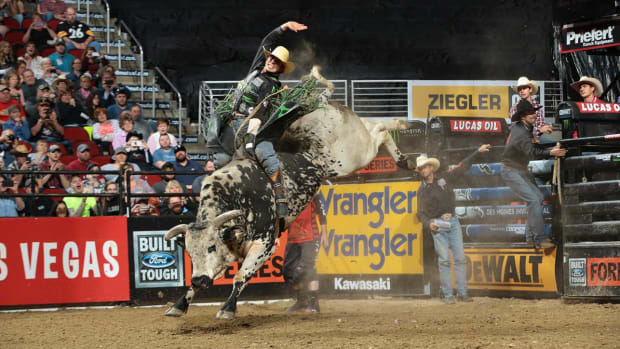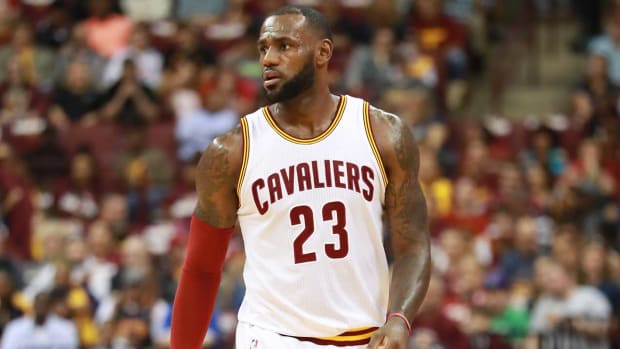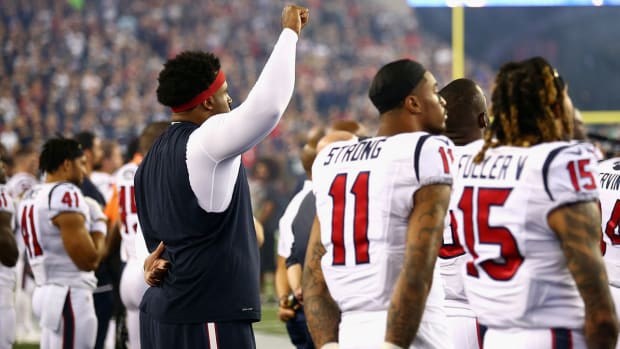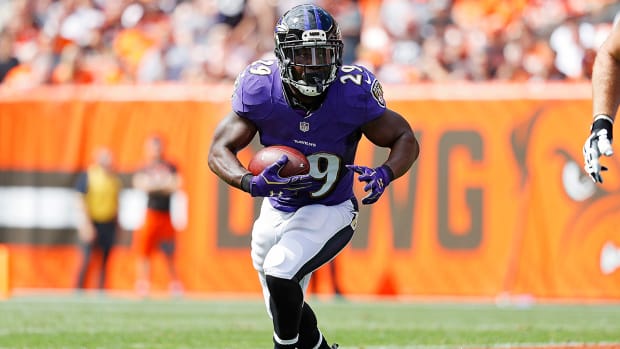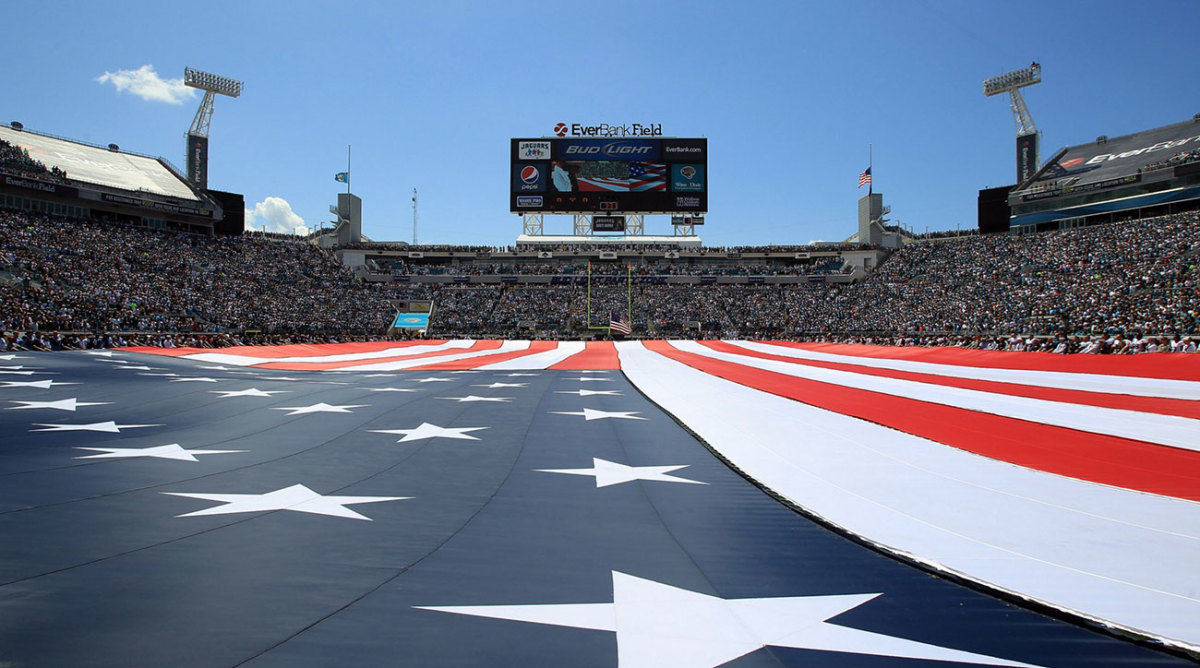
How the NFL sells (and profits from) the inextricable link between football and war
Fifteen years after the bloodiest day on American soil since the Civil War, we tend to remember Major League Baseball as the sport that did the most to heal the country in the aftermath of 9/11.
After all, it was the New York Yankees who rode a wave of civic resilience to a World Series appearance in the city hit hardest by the terrorist attacks. When the Fall Classic between the Yankees and the Arizona Diamondbacks aired on the Fox Network, American Airlines and United Airlines seized the opportunity. They ran poignant ads to convince viewers that air travel was safe again.
Arizona pitcher Curt Schilling’s belligerent editorial in USA Today captured the spirit of competition that spurred the Diamondbacks to deal the beleaguered city of New York a baseball defeat:
“My thoughts [on 9/11] turned to revenge, retaliation, retribution,” wrote Schilling in seething tones; “I believe our president when he says redemption will be swift and total.”
Our national pastime was most potent when America sought reprisal. Game 7 of the 2001 World Series remains the most watched — and arguably best played — professional baseball game of all time.
[youtube:http://www.youtube.com/watch?v=H9eE7fZSUt8]
But in the campaign for America’s hearts and minds in the post-9/11 period, baseball only won the battle. Football has won the, well, war. A second look at the 2000's — a “history of the present”, in the words of Michel Foucault — shows that football has been more than a sport these last 15 years; it’s been the medium to relay America’s military response to the trauma of terrorism.
Perhaps we don’t readily associate football and 9/11 because the crowning event of the NFL season didn’t take place until five months after the attacks.
Super Bowl XXXVI was played between the upstart New England Patriots and the juggernaut St. Louis Rams on February 3, 2002. By then, Fox News, the cable arm of Rupert Murdoch’s media conglomerate, had been banging the war drum for months. A New York Times report from 2008 eventually disclosed that the Pentagon had been planting pro-war “analysts” on the network. When NFL on Fox got its paws on Super Bowl XXXVI, it turned the game into a staging area for a steroidal brand of partisan patriotism.
Football's Endgame: What would happen if America's pastime just ... died?
The broadcast started with NFL players reciting a pastiche of patriotic quotes, including Teddy Roosevelt’s “we do not admire the man of timid peace; we admire the man who embodies victorious effort.” Throughout the game, NFL on Fox showed military commandos, battle maps, and crosshairs in its cutaway graphics. With New England leading 14–3 and the broadcast shifting to the halftime show, Cris Collinsworth seemed ready to personally deport Paul McCartney at the slightest hint of anti-American sentiment:
“You weren’t born in America,” the former wide receiver asked a defensive McCartney, “but you are proud to be here, RIGHT?”
As the decade wore on, the fittingly-named Patriots became the most prolific team in the country’s most popular sport; capturing the 2002 Super Bowl as well as titles in 2004 and 2005. In her 2009 book Ugly War, Pretty Package, media scholar Deborah Jaramillo describes how football in this period became a lens for interpreting Operation Iraqi Freedom, an event that football cheered for.
During a Fox News broadcast on the second day of the Iraq War, March 21, 2003, Vietnam veteran David Christian compared Iraq’s rag-tag resistance to a scrappy high school football team, and called America’s army “professionals.” That same day, CNN commentator Colonel David Hackworth proudly likened the United States’ armed forces to the Dallas Cowboys. Ironically, this was not a flattering look for America’s troops, since “America’s Team” had just ended the 2003 season at the bottom of their division with a paltry 5–11 record.
Years later, when NBC launched Sunday Night Football in 2006, it conscripted composer John Williams to write the show’s theme, hoping he would martial the same militaristic musical style he used for the films Star Wars (1977), Saving Private Ryan (1998) and War of The Worlds (2005). Williams’s score still makes a mid-season game between the Giants and Eagles seem like it has geopolitical implications.
It didn’t matter that NFL players such as Cardinals safety Pat Tillman and Rams center Jason Brown criticized the war; or that actual veterans detested insulting comparisons between the vicissitudes of combat and the triviality of sport.
What mattered was that subcultures like tailgating, fantasy football, and gambling helped the NFL become more popular than ever, and that this popularity coincided with — and exploited — the escalation of America’s wars in Iraq and Afghanistan.
Crushing blows to Cam Newton expose how poorly the NFL treats one of its biggest stars
Consider the ratings of professional sports in the 2000's:
As combat sports like boxing and MMA enjoyed increased popularity during the same period, football’s major competitors failed to capture the national imagination. The NBA Finals set all-time ratings lows in 2003, 2005, 2007; while MLB’s World Series suffered the same fate in 2002, 2005, and 2006. Meanwhile, the 2007 broadcast of Super Bowl XLI — which began with a report about a flag football game played by soldiers in Iraq — was the second most-watched TV program … ever.
With the peaceful pretext of society stripped away by terrorist provocation, post-9/11 America fully embraced the NFL, the sport with the grizzly gridiron gladiators.
Well before the 2000’s, the NFL had a cozy relationship with combat. An apt place to start for perspective on the modern era is 1984 — a year foreshadowed by George Orwell’s 1949 novel of the same name. From the film adaptation of 1984: “The war is not meant to be won. It is meant to be continuous.”
British announcer Nicky Horne began the CBS broadcast of Super Bowl XVIII on January 22, 1984 by telling viewers, “Wars get roman numerals, and it’s going to be war out there in a couple of minutes.” The words were barely out of his mouth before fighter jets from the 56th Training Squadron of nearby MacDill Air Force Base soared over Tampa Stadium.
Later that year, during his stand-up comedy special Carlin on Campus, George Carlin debuted the routine “Football and Baseball,” in which he delved into the deep linguistic echoes of football and war:
“In football, the object for the quarterback is to be on target with short bullet passes and long bombs,” rattled Carlin; “in baseball, the object is to go home and be safe.”
The Super Bowl would return to Tampa in 1991, one week after the onset of Operation Desert Storm. The NFL distributed 72,000 flags for fans to wave, then had the stadium PA dedicate Whitney Houston’s rendition of “The Star-Spangled Banner” to “the brave men and women serving America in the Persian Gulf.” During halftime, ABC cut to a Peter Jennings special report about the progress of the Persian Gulf War.
With 30-second ads running for some $800,000, Super Bowl XXV was at that time the most lucrative ad space in television history.
Then-commissioner Paul Tagliabue responded to the charge that the NFL was profiting from war by claiming that the league used its “best judgment” in determining what constitutes a tasteful display of patriotism. Absolutely none of this restraint was in place five years later in ABC’s outrageously hawkish 1996 opener for Monday Night Football:
Sports journalist Frank Deford reflected on this state of affairs in 2010, noting that “football provides us with nostalgia for the way war used to be: Clear battle maps, focused campaigns, simple battle lines.” His words recall the Civil War, when spectators gathered with picnic blankets to watch battles at Bull Run and Manassas, Virginia.
Seen in this light, America’s infatuation with the double helix of football and war is written into the cultural and regional DNA of the United States. Both professional football and the armed forces are dramatically overpopulated by those who hail from the American sunbelt and a handful of southern states, in particular.
According to Business Insider, over half of all NFL players at the start of the 2015 NFL season came from only eight states: California, Florida, Texas, Georgia, Ohio, Virginia, Louisiana, and North Carolina. Six of these states (CA, TX, VA, FL, GA, NC) also rank first thru sixth on the list of U.S. states by population of active duty and reserve members of the military.
When one looks at states producing the most NFL players on a per capita basis, football’s regional divide intensifies to exclude all states not located in the Deep South. An annual study conducted by USA Football at the start of the 2015 NFL season shows that Alabama leads the way, producing one player for every 75,869 residents. It was followed by Louisiana (1:78,162), Georgia (1:84,979), Florida (1:92,163), Mississippi (1:92,728) and South Carolina (1:98,142).
By collectively producing one NFL player for every 87,007 residents, these six Deep South states are 2.5x as likely to produce an NFL player as the other 44 (1:228,695). Per enlistment data provided by the Department of Defense in 2014, a member of the military is also 55 percent more likely to come from these six states than from anywhere else in the country. (Incidentally, each of the six states in question ranks in the bottom 20th percentile on the list of U.S. states by poverty rate.)
The regional and socioeconomic segregation of America’s armed forces has led former Secretary of Defense Robert Gates to comment that “there is a risk of developing a cadre of military leaders that have less and less in common with the people they have been sworn to defend.”
Author Malcolm Gladwell has echoed similar concerns about football, saying in the 2013 documentary United States of Football that the sport was in danger of becoming “ghettoized”:
“We’ll get to a point where we disclose the risks of football and dare people to play,” asserted Gladwell; “that’s what the Army does, and that’s what football is going to become.”
The future Gates and Gladwell feared is already here: A world where football finds its demographic doppelgänger in an increasingly distant defense establishment. While rallying to fight a “War on Terror” abroad, a divided America is still struggling with the vestiges of Civil War at home.
The NFL’s social base in military-heavy areas is the backdrop of the backlashagainst San Francisco 49ers QB Colin Kaepernick. After Kaepernick explained his decision to protest police brutality during the singing of the national anthem at the start of a preseason game on August 26, reporters questioned whether he felt his actions disrespected the armed forces.
National anthem's history makes for an unwieldy weapon to use against Kaepernick
Days later, Seattle Seahawks QB Russell Wilson cited his familiarity with Naval bases near his off-season training station in San Diego and “the pain of 9/11” as reasons why he would not replicate Kaepernick’s protest. At the same time, so many servicemen and women have sided with Kaepernick, that #VeteransForKaepernick was briefly the top-trending hashtag on Twitter.
In this polarized climate, the NFL attempts to relate the country’s differences through the conduit of pop culture. On their Sunday Night Football broadcasts, NBC uses white country musicians to market a league that is 68% black to an audience that is 77% white. By projecting the stylistic extremes of race, the network encourages all of America to meet somewhere in the middle.
In recent years, the NFL’s curation of war has walked a similar tight rope.
As the costs of America’s military entanglements have mounted and become politically unpopular, league celebrations of the armed forces have grown more subdued. When Fox’s NFL pregame show on November 8, 2009 went live from Bagram Airfield in Afghanistan, the network highlighted the country’s humanitarian efforts instead of its combat missions
Two years later, in the lead up to the 10th anniversary of 9/11, NFL Commissioner Roger Goodell claimed that his goal was “to help the country heal.”
[youtube:http://www.youtube.com/watch?v=XCzP8-VbriM]
And yet no institution has done more to continue tying football to war than the Department of Defense.
A 2015 report by the U.S. Senate, titled “Tackling Paid Patriotism,” reveals that from 2011 thru 2014, the DoD paid $5.4 million to 18 NFL teams in exchange for ceremonies that celebrated the armed forces. Air Force flyovers, decorated generals conducting the pregame coin toss, and soldiers running on field with the flag? All are bought-and-paid-for displays of patriotism.
The largest of these DoD-NFL contracts generally tended to go to franchises in the south or sunbelt: The Atlanta Falcons ($879,000); the Baltimore Ravens ($534,500); the New Orleans Saints ($472,875); and the San Diego Chargers ($453,500). Exceptions to this rule include the team in the non-Sunbelt State with the largest population of military enlistees (the Seattle Seahawks, $453,500), and — of course — the New England Patriots ($700,000).
The human costs of war belong mostly to states in the American South. But everyone can buy into well-branded patriotism.
In the groundbreaking 2013 documentary League of Denial, sports reporter Stan Savran guessed that “football fits the personality of a society that has become more violent.” If only he were right. If the ravages of actual war were played out more often on American soil, perhaps society would have a different attitude towards pop culture celebrations of military conflict.
“Football,” sportswriter John Oriard has written, “has meant whatever we’ve needed it to mean at any given time.”
How many will say we need it to stop selling us the spectacle of war?

